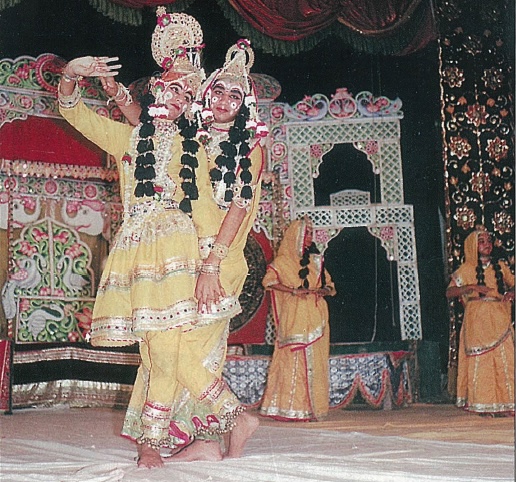By Kumud Mohan
Suddenly there was pin-drop silence. A refined gentleman in a silk kurta and dhoti, a tika, or mark on his forehead, and a plate with items of worship in his hands, emerged from the wings. The sound of a conch shell was followed with the tinkling of a temple bell. The plate was then swung in arati, or prayer, around the principal artists of the dance-drama. Finally, their guru, who held the plate, as well as all the onlookers, prostrated in front of the couple in veneration.
The artists, overwhelmed with emotion, conferred blessings on their guru. For the next 45 days and nights they would be assuming the roles of Lord Krishna and Goddess Radha, hoping to match their deeds and thoughts to the divine drama.
The teenage boys–for Radha, too, was a boy dressed as a girl–were among a dozen others who had left their families at a young age to join Rasacharya Ram Swarup Sharma’s renowned raas mandali (troupe). Raas stands for the essence of all the rasas, or emotions in Indian literature. As devout members of the mandali, they would henceforth shun vices such as meat, alcohol and smoking. Their demanding 14-hour daily schedule of dance, drama, music and academics would cut them off from the rest of the world. But they were content. To be a part of a raas mandali was a rare achievement!
The story goes that raas was occasionally performed some 5,000 years ago by Lord Krishna and his brother Balaram, with Radha being Krishna’s main partner. One day, however, Krishna deserted Radha, and the weeping maiden and her friends enacted episodes from Krishna’s life in order to keep his memory alive. And so, legend has it, the first raas leela was performed. Leela, or playfulness, is the depiction of the playful episodes from the life of Lord Krishna.
The first historically recorded raas leela was based on episodes from the Srimad Bhagvad Purana. It was performed starting in the 16th century at Vishram Ghat in Mathura, the birthplace of Lord Krishna in western Uttar Pradesh, India, under the auspices of Guru Vallabhacharya and his disciples. This sowed the seeds of the present raas leela tradition.
Today, there are over 100 raas mandalis touring India and abroad. They converge on the sacred land of Braj, presently the area between Kosi and Agra including Mathura, during the auspicious months of August and September, to relive the times when Radha and Krishna reveled in their romance in gentle monsoon showers. All the artists are male–in keeping with the tradition of the first raas at Vishram Ghat 500 years ago.
For 45 days and nights different episodes from the lives of these divine lovers are enacted with great fervor by the artists in several huge pandals, or make-shift theaters, free to all who come.
